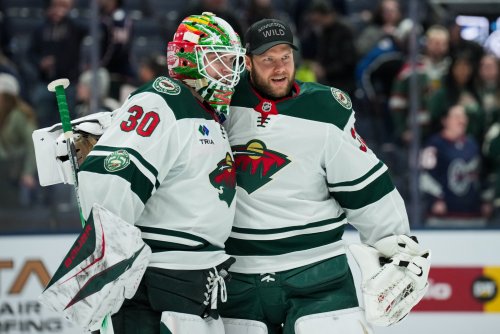
One of the biggest concerns for the Minnesota Wild this year is their sudden turnover on defense. Four of their seven defensemen from last year are gone, a massive shock to a previously stable unit. The last time their Top-4 was changed was 2016, when Matt Dumba first took on 20-plus minutes a night.
Ryan Suter only missed nine games after signing his mega-contract in 2012. But now Suter is gone, as are bottom-pairing defensemen Carson Soucy, Ian Cole, and Brad Hunt. In came Alex Goligoski, Dmitry Kulikov, Jon Merrill, and Jordie Benn. Minnesota’s immediate concern is whether they can stabilize the situation enough for their defense to still be considered a strength.
We’ll start finding out the answer tonight, but the lost impact goes way beyond the defensive zone. What we can be relatively certain of is that these additions won’t replace the Wild’s lost offense. Suter had a down season (perhaps coincidence, perhaps age-related), but was good for 45-points a year before that. Soucy was 15th in points per hour at 5-on-5 among defensemen with 1000-plus minutes these past two years.
Those are huge losses along the left side, and someone needs to pick up that offensive slack. Might that player be Jonas Brodin? The longtime defensive defenseman raised eyebrows last season by putting up some Suter-like numbers. Brodin scored a career-high nine goals, and his 23 points trailed his previous best only by five.
Extrapolate those rates out to 82 games, and that’s 14 goals and 36 points. Those numbers won’t win him a Norris Trophy, but they represent a legitimate offensive step for the light-scoring defenseman. He’s gone from averaging 22 points per 82 games to being able to reasonably replace Suter offensively.
Or so it would seem.
Fans have wondered for years why Brodin — an incredible skater with good vision — couldn’t put up points. Suter didn’t boast Cale Makar-like puck skills, but he racked up assists just by touching the puck a lot. Brodin didn’t benefit from the power play minutes Suter got, but even at 5-on-5, Brodin lagged behind Suter.
This doesn’t make much sense given his skills, leaving the State of Hockey ever hopeful for a breakout. No one can blame any fan that saw his relatively big numbers and thought it was a leap.
Look deeper, though, and you just don’t see a radically different Brodin. Since the goals are the headline, let’s start there. He shot 4.6% for his entire career up until last year, when his shooting percentage inflated to 11.4%. Did Brodin do anything differently to prompt such a change?
At first, it looks like it does. Brodin scored those nine goals on 4.8 expected goals, or 0.24 per hour. That’s almost double his career rate of 0.13 prior to last year. Still overperforming, but there’s growth there. So let’s look at his shot chart from last year to investigate further.

There’s a lot of low-percentage shots from the point here. Occasionally Brodin ventures to the slot, though his chances don’t get much more dangerous there. You’d say his goals were a product of being able to beat goalies from distance, until you realize there’s only three 5-on-5 goals here. That’s a bit weird.
So, let’s look at his nine goals individually to see what happened.
- Jan, 14: 5-on-5, Brodin crashes slot, finds a loose puck, scores on a wrist shot.
- Jan, 31: 3-on-3, Brodin scores on a one-timer from the slot.
- Feb. 22: 5-on-4, Brodin scores off cross-ice pass from the slot.
- March 8: 5-on-6, Brodin awarded goal after getting slashed on an open net chance.
- March 12: 5-on-6, Clearing attempt deflects off wall and into empty net.
- April 19: 5-on-6, Brodin scores from defensive zone into an empty net.
- April 28: 5-on-5, Brodin one-timer from the point, may or may not have been deflected by Joel Eriksson Ek.
- May 1: 6-on-5, Brodin scores on point shot.
- May 3: 5-on-5: Brodin scores on shot from the point.
You can’t take away from what Brodin did — he did actually score those nine goals — but is it repeatable? Over his final 40 games, his goals either came from empty-net situations or the point. Relying on low-percentage point shots isn’t a recipe for consistent offense in this league. As for empty-net goals, they’re useful, but when you imagine a player taking an offensive leap, you usually don’t think of them fattening up on an empty net.
If his goals were in line with his expected, he’d have about five on the season instead of nine. Over 82 games, that’s seven or eight goals and a total of 29 points. That feels more in line with his career, and a projection resembling his career is much more reasonable than assuming an offensive breakout.
Brodin is 28 years old, not 24, with over 13,000 NHL minutes in his career. He logged over 20 minutes a night in each of his last four seasons, and eight of his nine total. Even with Suter gone, he won’t be getting much more of a role than he already has. It’s extremely rare to see a player with so much NHL time break out offensively at that age. At this point in his career, Brodin is who he is.
Fortunately for Minnesota, that’s an incredibly good hockey player. At this point, Brodin should be undisputedly considered the best defensive defenseman in the league. And with the blue line in flux, that reliably elite defense will be much more valuable for them than a bump from 25 to 35 points.
All data is from Evolving Hockey unless otherwise stated.
Think you could write a story like this? Hockey Wilderness wants you to develop your voice, find an audience, and we'll pay you to do it. Just fill out this form.







Recommended Comments
There are no comments to display.
Join the conversation
You can post now and register later. If you have an account, sign in now to post with your account.
Note: Your post will require moderator approval before it will be visible.